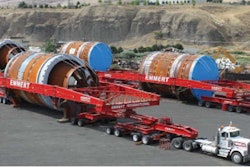Meals on wheels
Forget the humble hot dog cart. Gourmet dining is now hitting the streets, and that requires a special kind of truck.
Chef Tai Lee’s business is on a roll. Literally.
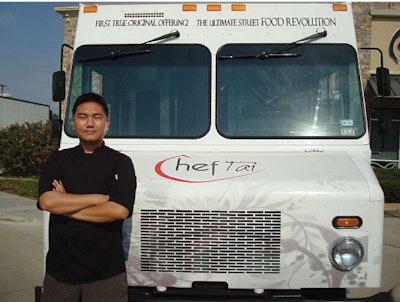 Tai Lee, who operates Veritas Wine and Bistro in College Station, Texas, is among the growing number of chefs who is introducing gourmet fare to curbside foodies.
Tai Lee, who operates Veritas Wine and Bistro in College Station, Texas, is among the growing number of chefs who is introducing gourmet fare to curbside foodies.The star restaurateur behind the Veritas Wine and Bistro in College Station, Texas, is among the growing number of chefs who are successfully introducing gourmet fare to curbside foodies. And forget the image of stale sandwiches served up by a neighborhood coffee truck. Chef Tai’s Mobile Gourmet Food Truck – recently named in a national competition as America’s Favorite Food Truck – offers cuisine such as barbecue pulled pork tacos, Brussels Tofu Florentine and American Wagyu burgers with au Poivre sauce.
The latest generation of rolling kitchens can be traced to food-focused television shows and new chefs who dream about owning their own restaurants, Lee says. “That explains half the story,” he says. “With the current economic meltdown, we see more displaced chefs and nonrestaurant-industry personnel who are seeking a new venture to replace their income.” Combine these factors with price-conscious diners who have demanding palettes, and you have the foundation for a culinary trend.
In a survey of 1,000 adults this August, the National Restaurant Association discovered that no fewer than six out of 10 consumers would visit a food truck offered by a favorite restaurant; 28 percent of those who saw a food truck this summer actually reached for their wallets.
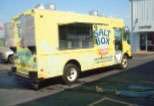 The most common trucks are created on a platform of step vans with 16- or 18-foot box lengths.
The most common trucks are created on a platform of step vans with 16- or 18-foot box lengths.The trucks certainly are building legions of fans along the way. Many diners monitor Twitter feeds to see where their restaurants of choice will be parked on any given day. Trucks and their chefs even have become reality television stars thanks to programs such as the Food Network’s “The Great Food Truck Race” or the Cooking Channel’s “Eat St.”
Not your grandpa’s food wagon
Today’s gourmet food trucks include more features than the simple griddle or deep fryer found in a basic design. Lee’s 2007 Ford E-350 step van, which also supports his restaurant’s catering business, is equipped with a char broiler, convection oven and stove top. There is also a pair of coolers, sinks for hands and dishes, steam tables, a vent hood, a fire suppression system and hidden storage areas.
Every item in the cramped space is chosen to support a refined business model. The newest rolling restaurateurs often want to “throw every piece of equipment known to man into the truck,” says Kenny Allen, chief operating officer of Vending Trucks Inc. But Allen knows that the most successful operators tend to focus their menus and spec their trucks accordingly.
Many of the chefs who investigate these trucks for the first time simply are used to feeding 500 guests a night from a kitchen that is four times the size of a truck, says Justin Harris of Kitchen on Wheels in New Braunfels, Texas. “We have to take that concept and shrink it in a way as to not take away functionality from the kitchen,” Harris says.
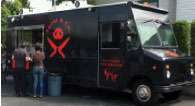 Typical food truck designs often weigh somewhere between 12,000 and 13,000 pounds.
Typical food truck designs often weigh somewhere between 12,000 and 13,000 pounds.Of course, personal preference is only one factor to consider; local health codes play their own roles in the designs. While Los Angeles and New York tend to have the strictest rules, every jurisdiction presents specific needs. A food truck that operates in New Jersey will need to be equipped with a 40-gallon tank for freshwater and a 60-gallon tank for wastewater; these sizes will vary from one region to the next. The windows in a truck in Los Angeles, meanwhile, will be narrower than those parked on the East Coast.
Tasty spec’ing
Then there is a matter of meeting menu-specific requirements. When Vending Trucks introduced a vehicle with eight instant milkshake machines and a freezer, it needed a 300-gallon tank for freshwater and 350 gallons for wastewater. “I had never seen a 300-gallon tank before,” Allen says. Another truck required wiring to plug into 220V 60-amp shorepower, making it possible to operate indoors.
The physical space also can present unique challenges. The most common trucks are created on a platform of step vans with 16- or 18-foot box lengths, but equipment designers boast that they can build a kitchen in virtually any vehicle. Kitchen on Wheels has worked with everything from trailers to step vans and Dodge Sprinters as long as the latter vehicles are 3500 models with a 170-inch wheelbase and dual axles.
Gourmet food trucks and their chefs have become reality television stars.
Some platforms simply are more challenging than others; Airstream trailers offer a perfect example of that. “Those are not only rounded, but they’re very thin-skinned,” says Arthur Djahani, general manager of Armenco Cater Truck Manufacturing in Sun Valley, Calif., referring to the way these spaces will require an enhanced skeleton and curved cuts.
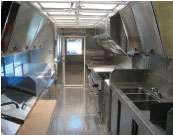 The latest generation of rolling kitchens can be traced to food-focused television shows and entrepreneurial chefs.
The latest generation of rolling kitchens can be traced to food-focused television shows and entrepreneurial chefs.Regardless of the space that exists, appliances quickly can eat up the room on either side of any 30-inch aisle. While most of the equipment tends to include the same commercial appliances found in a typical restaurant kitchen, some emerging options are designed to conserve valuable real estate, says Djahani. Royal Range has adjusted the size of the bull nose at the front of one range and added elbows to the gas lines so everything will fit tight against the wall.
Appliance choices also present unique energy needs. Hot surfaces tend to rely on fuels like liquid propane, but everything from coolers to blenders relies on electricity, requiring a careful focus on generator choices. It is a matter of matching the power-producing tools to the specific needs; a 7,000-watt generator may support a pump, water heater, interior lights and GFI outlets in a simple sandwich truck, but Kitchen on Wheels needed to equip a Dodge Sprinter with a 30,000-watt generator to support a customer with a gourmet coffee business.
Those who spec generators need to be conscious of noise and exhaust, Harris says. “The last thing you want is a noisy, smoky generator that is going to turn people away,” Harris says. That’s why generators tend to be mounted on the driver’s side of a food truck, isolating the noise from customers at the curb.
Then again, that presents another challenge for manufacturers. Typical food truck designs often weigh somewhere between 12,000 and 13,000 pounds, and the heaviest equipment like grills and generators always tend to be on the driver’s side of the vehicle. “During buildout, we’ll move whatever we can to the right side,” says Djahani, referring to equipment such as propane and water tanks. But even when the shifts are made, the suspension likely will require a few well-placed leaf springs to balance the load and help extend the life of everything from tires to brakes.
“None of these vehicles are designed to take turns at 30 to 40 miles per hour,” Allen says. But with careful attention to detail, they will deliver meals on wheels to a wider, growing audience.






